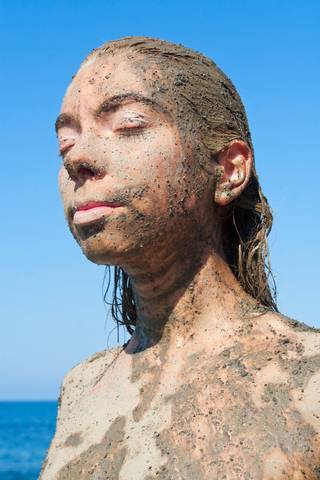For eons, mud baths have been used as a spa day treatment. Their medicinal benefits have been debated for a long time. There is evidence they are beneficial, but no long term studies have been conducted to prove this one way or another. What we know is that mud baths, mud wraps and mud facials are popular spa day treatments that many swear makes their skin feel softer, eases arthritis pain and relaxes the body. This post covers the three main types of mud used in a spa day treatment. Oh and yes, you can enjoy a mud bath as part of your personal spa day at home.
What does mud do besides make you muddy?
There is limited evidence, but evidence none the less that indicates that a mud bath can relieve the pain of arthritis and it can be a totally relaxing spa day experience. In addition, there are many claims that a mud bath draws toxins in your body out through your pores.
My mom was a heavy smoker and took a mud bath at one of the spas in Calistoga, California. I don’t recall which one. What I do remember was her telling me the mud smelled like sulfur. She told me that after the bath she rinsed and the towels she used to dry with were stained with that telltale characteristic yellow of cigarettes. That’s the only proof I have to offer you that mud baths draw out toxins. It was proof enough for me.
What mud to use
There are a number of permutations of the basic three kinds of mud used for a mud bath. The basic four are sea mud, moor mud, mineral mud and clay.
- Sea mud – is collected from the ocean and salt lakes. It’s rich in minerals, exfoliates the skin and eases sore muscles and joints. The mud from the Dead Sea is perhaps the most famous.
- Moor mud – is collected from the bottom of ancient lakes and is rich in phytochemicals. It exfoliates and sooths skin.
- Mineral mud – is collected from areas with hot mineral springs. It is considered by some folks to be the best mud to relieve the pain in joints. However, a small test on arthritis sufferers demonstrated that Dead Sea mud was also beneficial.
- Clay – used in spa day treatments are from bentonite or kaolin clays. Bentonite is a clay made from volcanic ash and bentonite is a soft white clay. Clay is less expensive than the other mud treatments with many of the same benefits. It tightens pores, draws out toxins and is useful for soothing sore muscles.
Conclusion
This post is kind of a mud bath spa treatment 101 post. Later posts will show you how to use these mud treatments right in your own home. For sure, that will save you a bundle of cash and allow you to reap the benefits of a mud bath any time you choose.
Now go have fun and relax.
Related articles:

